
October 28, 2019 (Monday) – 9:35 pm
Hotel Milan – Negreira, Spain
Today’s Walk: Santiago to Negriera
After nearly 500 miles backpacking since September 12th, J’Nell and I are not finished yet. We’re going to amble another 55 to the coast in Fisterra, where it was once thought to be the end of the world (and maybe still is to the flat-earthers). It will be four more days navigating a plethora of hills.
And then there’s the weather. The Galicia region of Spain is vibrant green for a reason. Copious amounts of rain dump in the region, and the forecast calls for exactly that this week.
We wake to rain in Santiago, but before heading west we need to go back to the Pilgrim’s Office. This is to get our new passports (while a continuation of the Camino, the hike to the ocean is considered separate) and some maps/information. We’ve both done almost no research on what to expect these next four days.
Upon leaving the pilgrim’s office the sky clears. We see Hannah, our friend from New Zealand, and she’s setting out for the coast today as well. After chatting, we return to the hotel for a hearty breakfast since support services are supposed to be few and far between this late in the season, and are on the trail around 10:30 am.
I smile upon seeing the first Fisterra/Muxia marker (89.586 for the former, 86.482 kilometers for the latter), and it feels right to be carrying the pack again. We heard walking becomes an addiction, and it’s true. Hiking west to new towns in this wonderful country has become our lives, and I love it.
I’m going to have to reconcile stopping at some point, but not today.
We climb a hill to leave town, and turning around we look at the Santiago cathedral spires one last time. After walking so long to that place, it’s strange to see it in the distance behind us. It begins to rain, and the way alternates between quiet country roads and natural paths. At this point we have yet to see anyone else.
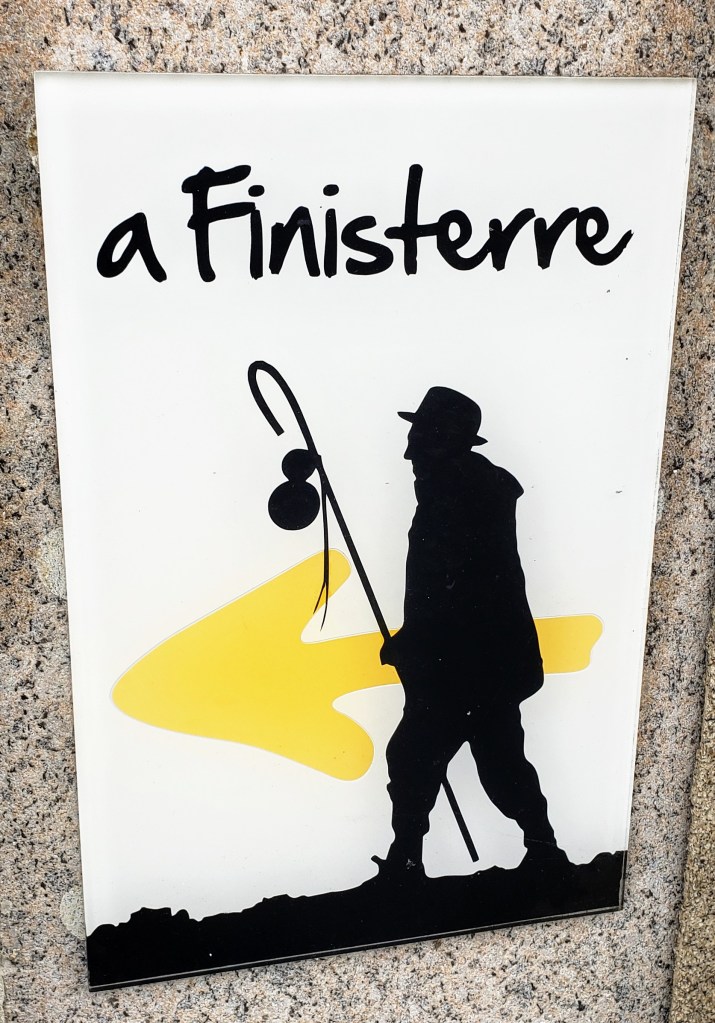
It’s Finisterre in Spanish, Fisterra in the local Galician language 
First Fisterra marker 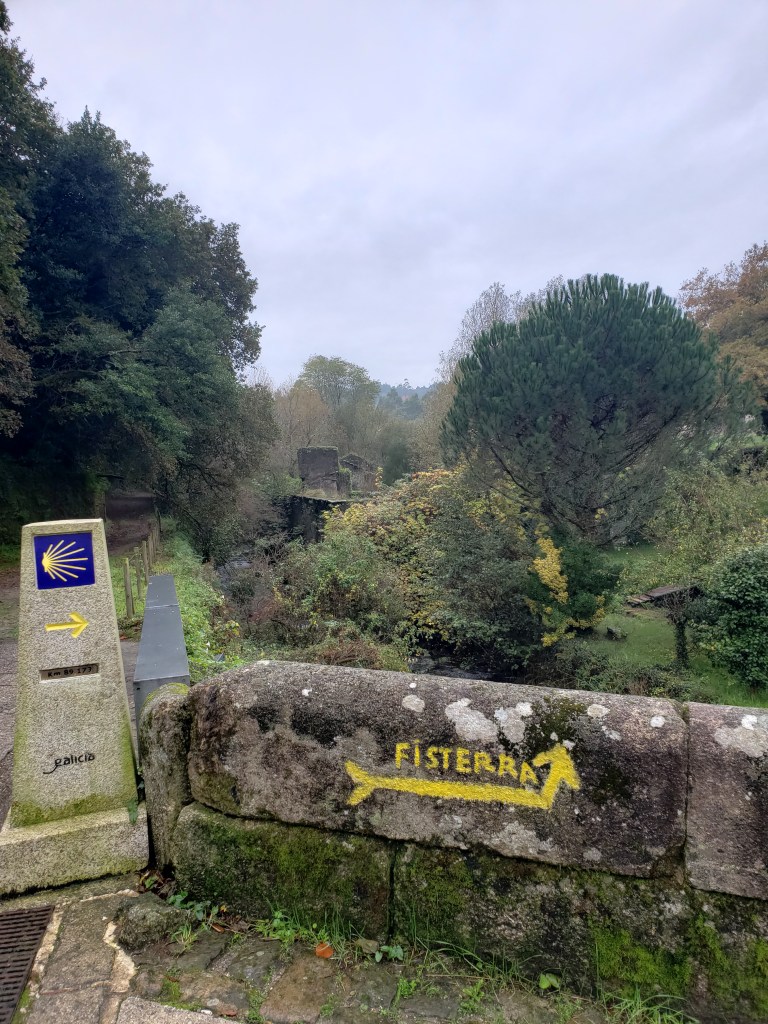

Leaving Santiago, the place we had been walking towards for so long.
In the town of Ames, we watch the fog cling and dance in the green hills that we will soon be climbing. We pass one restaurant that is open, smelling some kind of meat from its grill, but we had read about a cool place called Kilometer 79 Café and plan to stop there for lunch. Unfortunately when we arrive its shuttered up for the season, so we continue onward in the rain.
The hill is long and seemingly never ending, and we trudge ahead in thick fog. We finally make it to the top and enter the hamlet of Pontemaceira. Its Roman bridge, which the town is named after (translating to “apple bridge”), has 5 arches and a long waterfall on one side, and the serene Tambre River winding through the trees on the other. It is an alluring place with water mills, stone houses, and what looks to be a small castle overgrown with green vines.
There are no restaurants open there, meaning zero rest or food for us until 4 kilometers later when we reach our ending point for the day. But at least the rain stops. It’s another long and steady climb to Negreira, and we’re happy to reach our roadside hotel and take off our wet shoes. We have a delicious dinner at A Esmorga, and retire to our room to write in our journals with a bottle of vino tinto purchased at the gas station across the street.

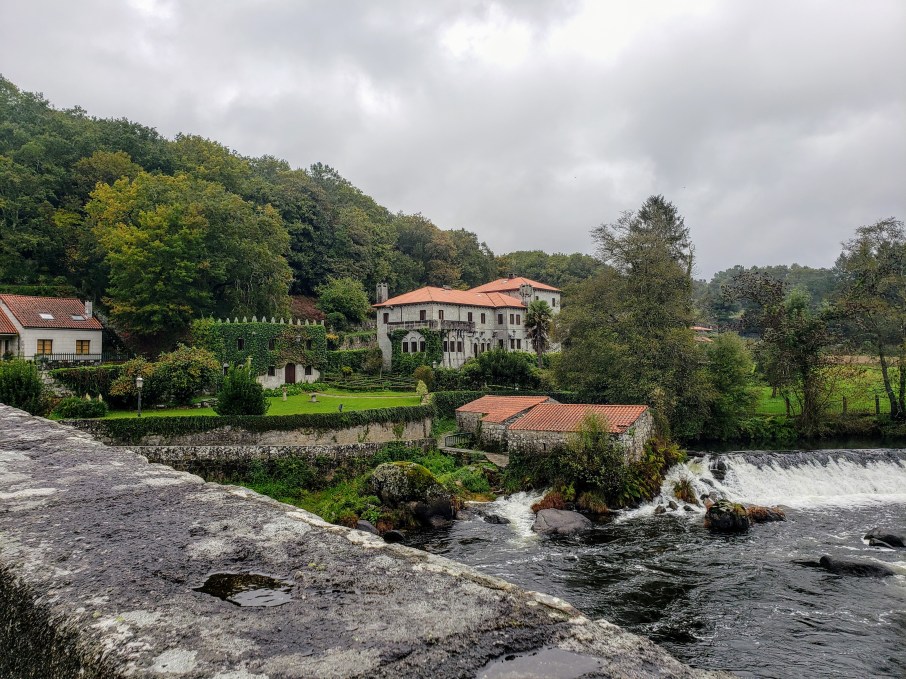

Photo credit J’Nell
October 29
Today’s Walk: Negriera to Lago
We wake to sun!
With a 17 mile hike ahead, J’Nell and I bask in the warmth, blue skies, and clean, crisp air. On the way out of Negriera we reach its long medieval arched wall and the church Capela de San Mauro that blends into it. We admire the gray stone structures in the autumnal splendor of brightly colored sun dappled trees in the morning light.
I put on my sunglasses, which have been useless these last several days, as we climb out of town. At the summit we look down on the panorama of Negriera in the blue sky. Regrettably, the good weather is not meant to last in Galicia, and when we head into the mossy and darkening forest, the sunglasses go into my pocket.
In the mist and fog we come upon Rachel and Terry, who have stopped to put on their backpack coverings. Butterfly introduced us to them in Santiago, and both are extremely nice (she is from Australia, he’s from England). After walking and talking for several minutes, they move at a quicker pace than us up the next hill and we lose sight of them; though we will see them again at the café where we soon stop.
Hannah is there as well on the patio under the awning, along with a group of 6 people in their 20’s speaking a few different languages. It seems as if everyone still walking the Camino is at Cafeteria Albergue Alto da Pena. Our break is also good timing, as just after we climb up the stairs past the sheep to the covered cafe, it starts to rain.
After coffee, cake and a sandwich, we keep ascending toward the modern windmills set in rolling green hills. The rain had stopped by the time we left, but it begins to drizzle now as we trek on the roadside with a narrow shoulder. At 1:30 pm we see a sign for our hostel that we booked, Monte Aro, informing us it is 14 kilometers away (8.7 miles).
Soon we’re off the highway and into a village where nothing is open, and then down a winding country road into verdurous fields with lots of cows. We fill our water bottles at a fountain featuring a mythical creature whose mouth is the spigot, and eventually reach a dirt path. It is beautiful country here, and the terrain has changed from dense forest to open land. The sun and blue sky make a brief return.



To find the cafe, take a left after the sheep 
J’Nell at the cafe 


Long way to go to our hostel 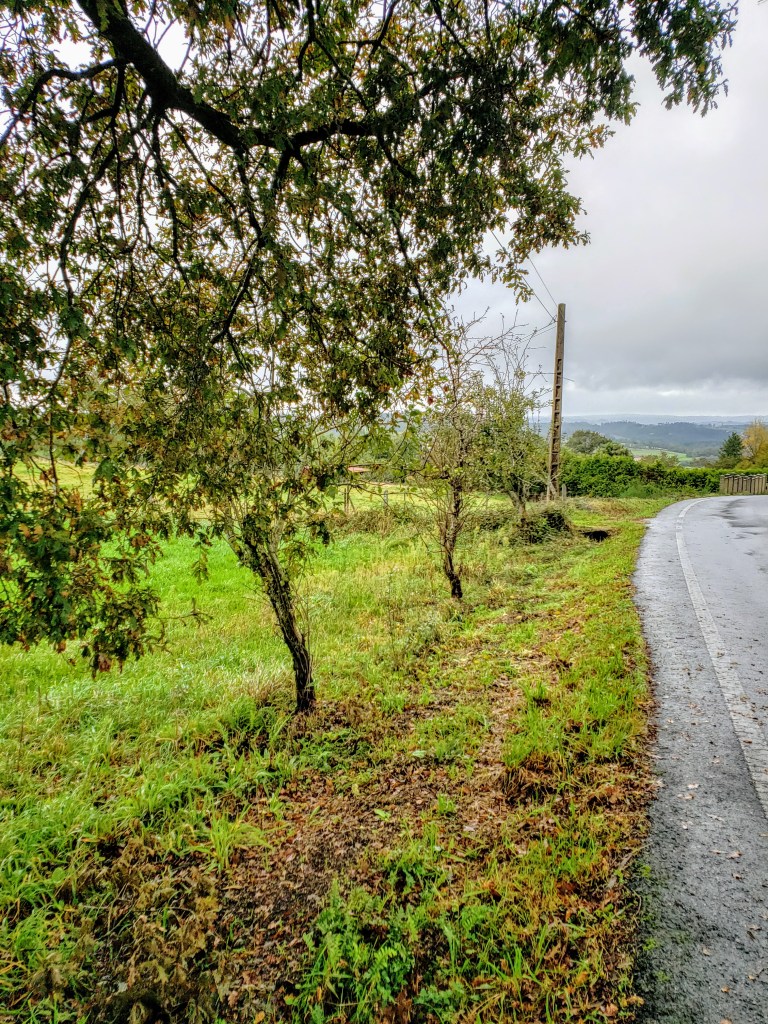
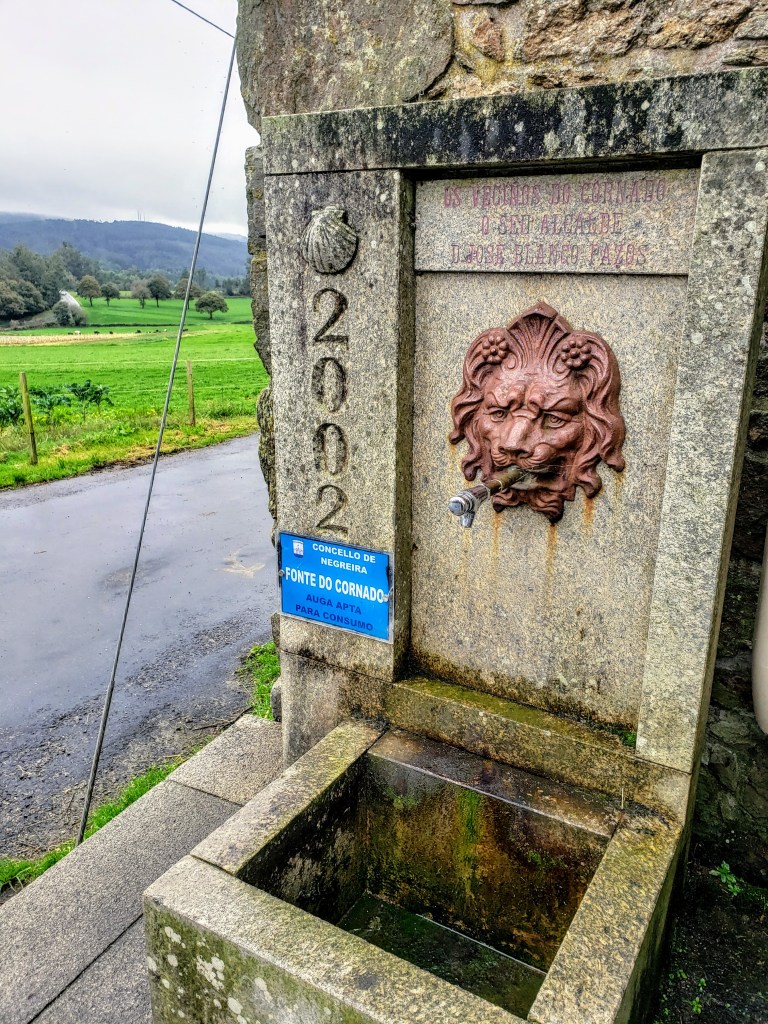
Nothing open in the town, but thankfully a potable fountain
We reach Santa Marina, which has a couple of albergues open that my Kindle book recommends, and not much else going on. You either sleep in this town, Lago, or else you charge far ahead into Olviera (making it a 33.4 km day from Negreira). We chose the middle option.
When we spot another sign for our albergue saying its still 7 kilometers away, we can’t help but think Santa Marina would have been a lovely place to stop. But there is no rain, and we find a roadside cafe called Casa Victorino for a coffee and to get off our feet. Upon leaving we are back into more beautiful landscape of big sky, rolling green hills, cows and chickens.

I love curvy, empty roads 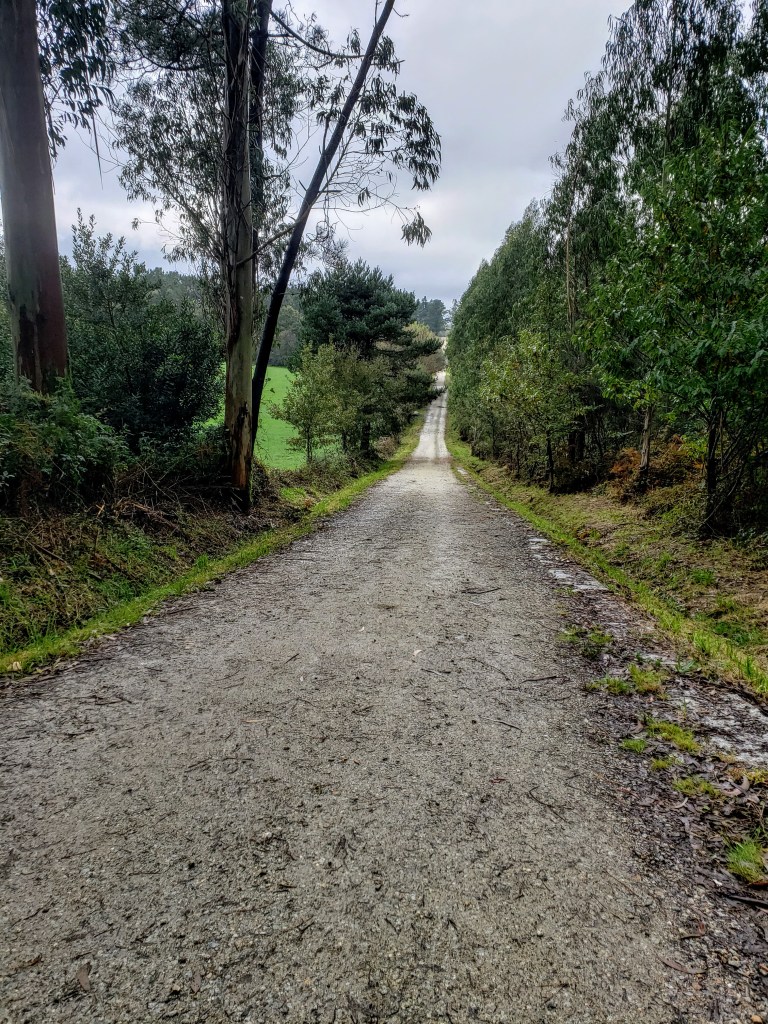

We had gone from mossy forests to open fields 

This section was so beautiful 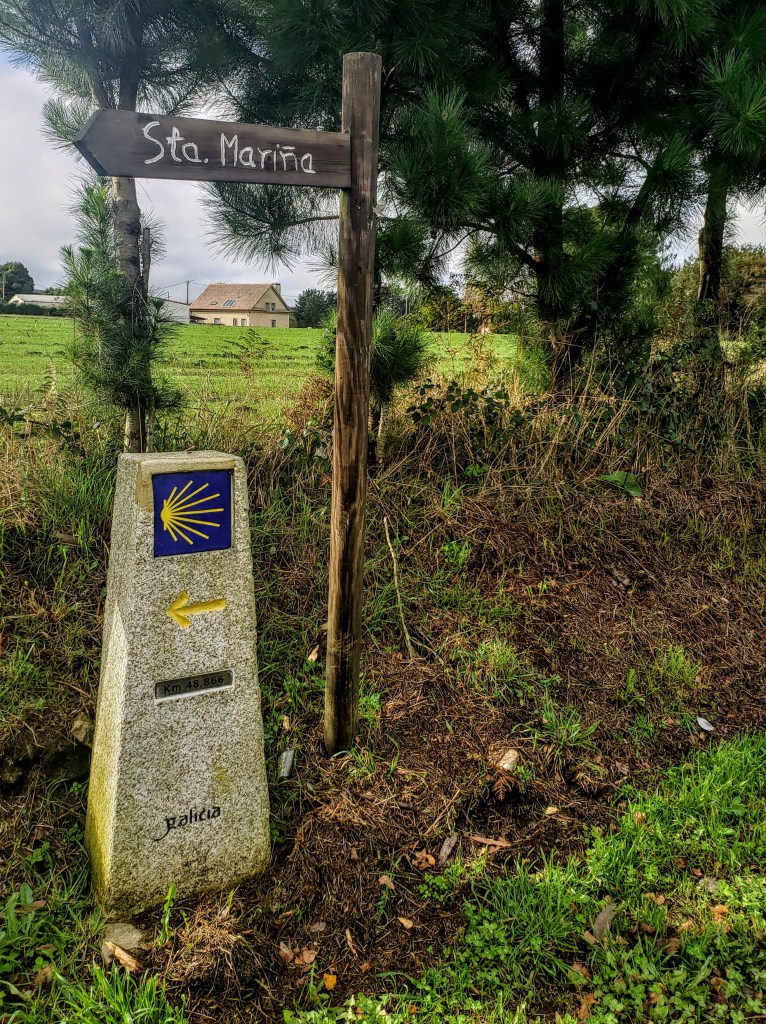

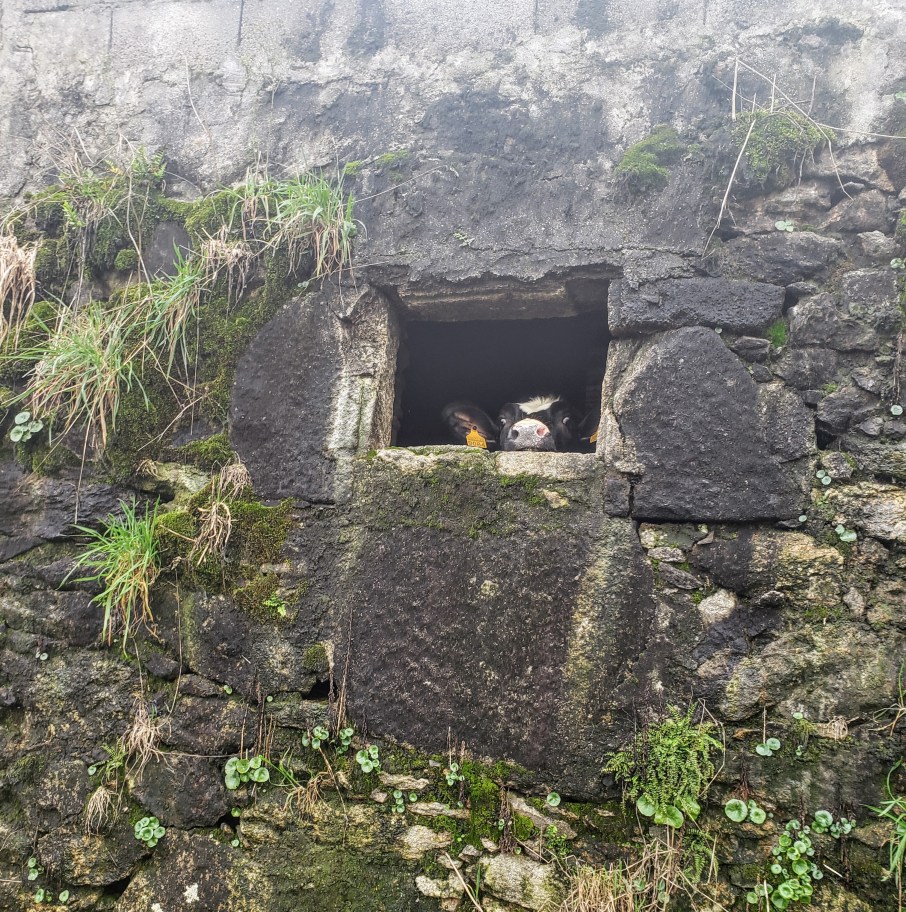
Poking his cow head out to say hi 
Lazy dog days of October
As we near Lago, thick fog rolls in and has an otherworldly quality to it. Since leaving the cafe in A Pena this morning, we finally encounter our first person on the road. His shadowy figure approaches us going in the other direction, and out in the middle of nowhere in this fog, we’re glad to see him wearing a backpack (some hardcore pilgrims actually hike to the coast and then hoof it back to Santiago).
We ascend a precipitous hill, and at the peak through the gray discover that we’re standing at a lookout point. I’m sure at other times the view is amazing, but we are lucky to make out the path in front of us. We almost expect to hear the galloping hooves of the headless horseman.
At 5:45 pm J’Nell and I finally reach albergue Monte Aro, which is new, clean, cozy and run by a cheerful woman. With few pilgrims there, we each get a bottom bunk that has its own light, plug, locker, sheets and comfy blanket. We are exhausted, and after a tasty dinner (I have a delicious chicken and cheese crepe) we go to bed.
Tomorrow we have 25 kilometers (15.5 miles), and it’s supposed to rain the whole day.


Fog Lookout Point 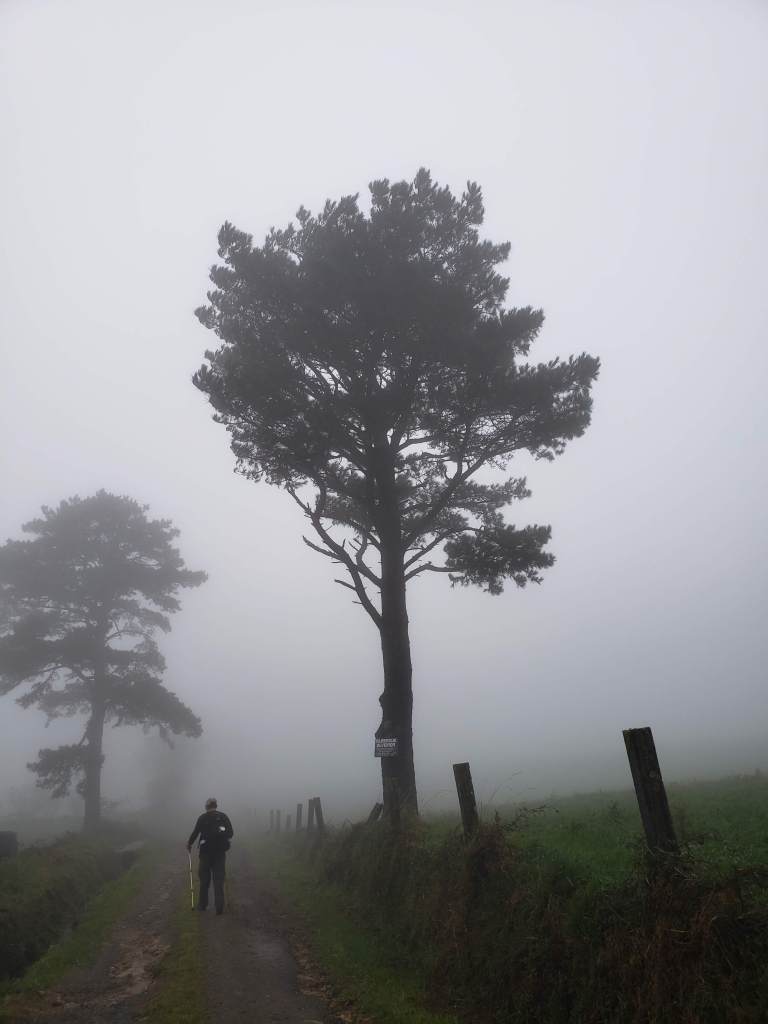
Getting lost in the fog (photo credit J’Nell) 
Finally made it!
October 30th
Today’s Walk: Lago to Cee
We leave the albergue around 9:00 am to steady rain and set out on the muddy trail. My phone won’t charge, likely from taking photos in the thick fog yesterday. I hope it’s just a temporary situation, and secure it in my dry bag inside my pack. Good thing it’s there when we reach the long, open field; the wind blows heavy rain at my side where I normally keep my phone.
J’Nell and I are both drenched when we arrive in Olviera, and we stop at a café for coffee and a tuna empanada (in Spain they love to put tuna in everything). I plug in my phone, but it still won’t charge. We’ll continue on in the rain along the highway past another town that has a large, cartoon-style painting of a pilgrim holding his staff with a mermaid swimming. Because that makes sense.
We finally reach a natural path free of cars, and begin to climb past longhorn cows into a boggy, muddy, busted-up stone road mess. This continues for miles, and it’s terribly slow going. Even though our shoes are soaked, we still try our best not to step in deep puddles.
We come into the town of O Logoso, which looks deserted except for a woman who has just gotten out of her car. She asks a donde va (where are you going), and when we reply Cee, she says it is quince (15) kilometers away. Aargh, still so far. We’re then once again walking up a narrow highway shoulder, and the fog is as thick as it had been yesterday.
At the top of the hill we reach what is called the bifurcation point, where you can go left to Fisterra or stay straight on the road to Muxia. It is here we see our first pilgrim of the day; he’s moving quickly, and after exchanging buen caminos he disappears into the fog towards Fisterra. That’s where J’Nell and I are going as well, and soon we’re on a dirt path snaking into green fields with tall trees and gigantic round boulders scattered about.


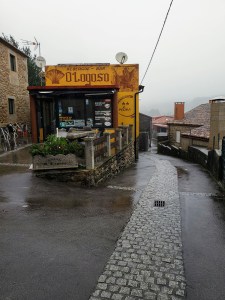

The bifurcation point (we went left) 

The worst part of the rain is keeping my glasses clear
At Capella da Nosa Senora das Neves (Our Lady of the Snows), a charming 15th century church surrounded by trees showing off fall foliage, there are picnic tables and a rest area. While the has rain stopped, unfortunately the tables are too wet to sit on because getting off our feet would feel magical. About 1.5 miles down the natural path we pass another old (from 1741) and closed church called Capella de San Pedro Matir, and we plod up more muddy trails.
At the top we get our first view of the ocean!
To have walked the entire length of Spain and finally see the Atlantic is a special moment. I truly grasp that the end of the journey is near. I feel no sadness, no relief.
I’m hit with the understanding of how far J’Nell and I have traveled, and have a deep appreciation of how lucky we have been to get here. I look down at the rocky coastline in the distance, all of it blending in with gray skies and fog, and it feels so good.
Cee is at the bottom of a steep descent, and about 30 minutes later we reach the cozy Albergue Moriera situated on the bay. It is 5:00 pm when we arrive, and after relaxing and showering (and getting my phone to finally charge!) we grab a beer at a local tavern and then a delicious dinner at As Baleas. Back at the albergue our private room has an ocean view, and J’Nell and I gaze out the window and sip some red wine.
We toast that we are less than ten miles to our destination at the End of the World!

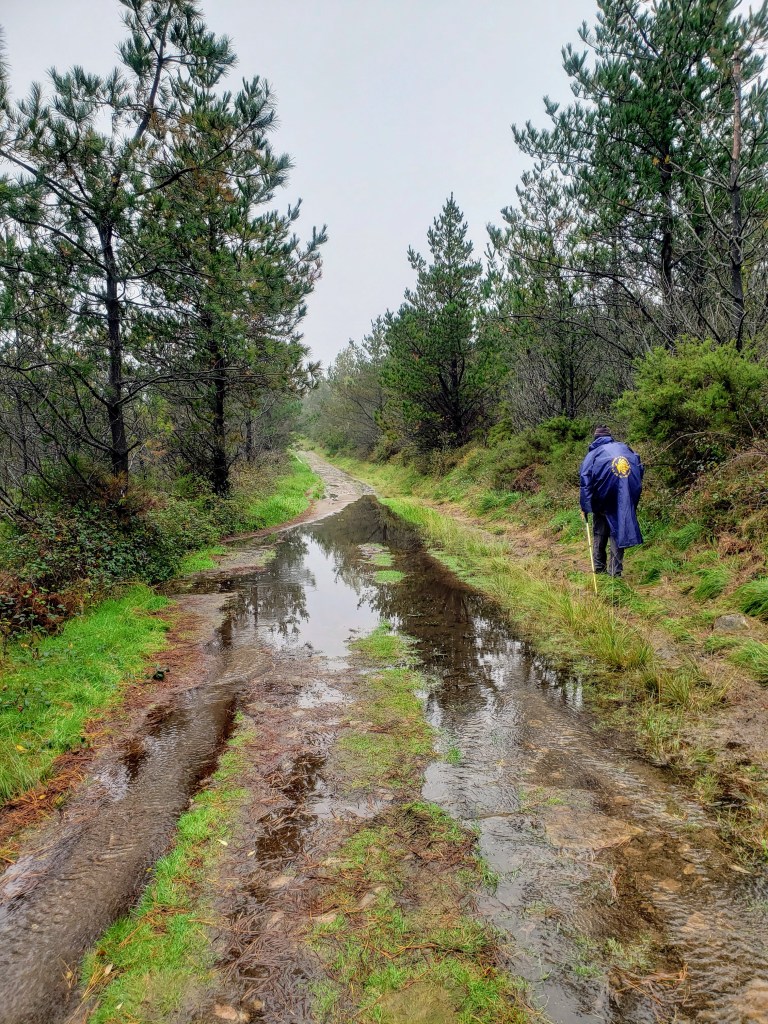
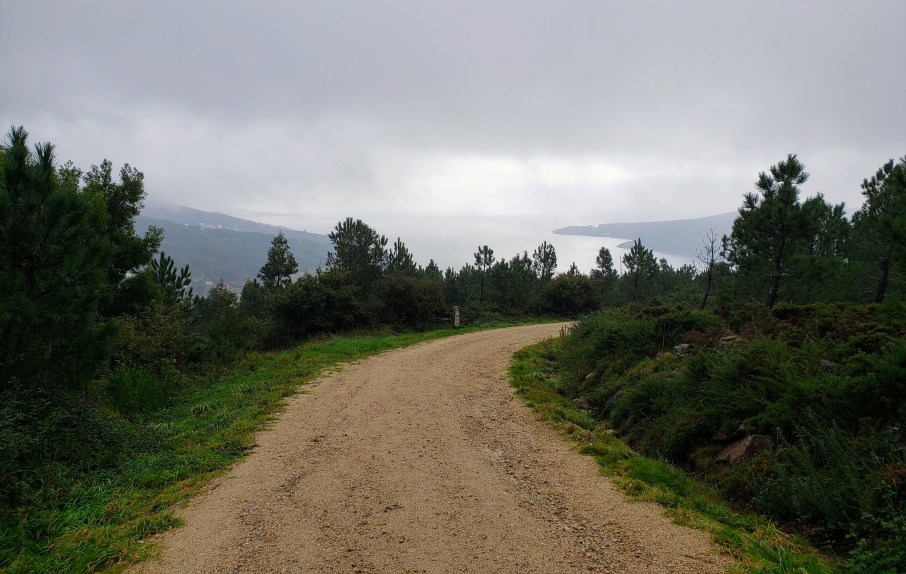
First view of the Atlantic Ocean! 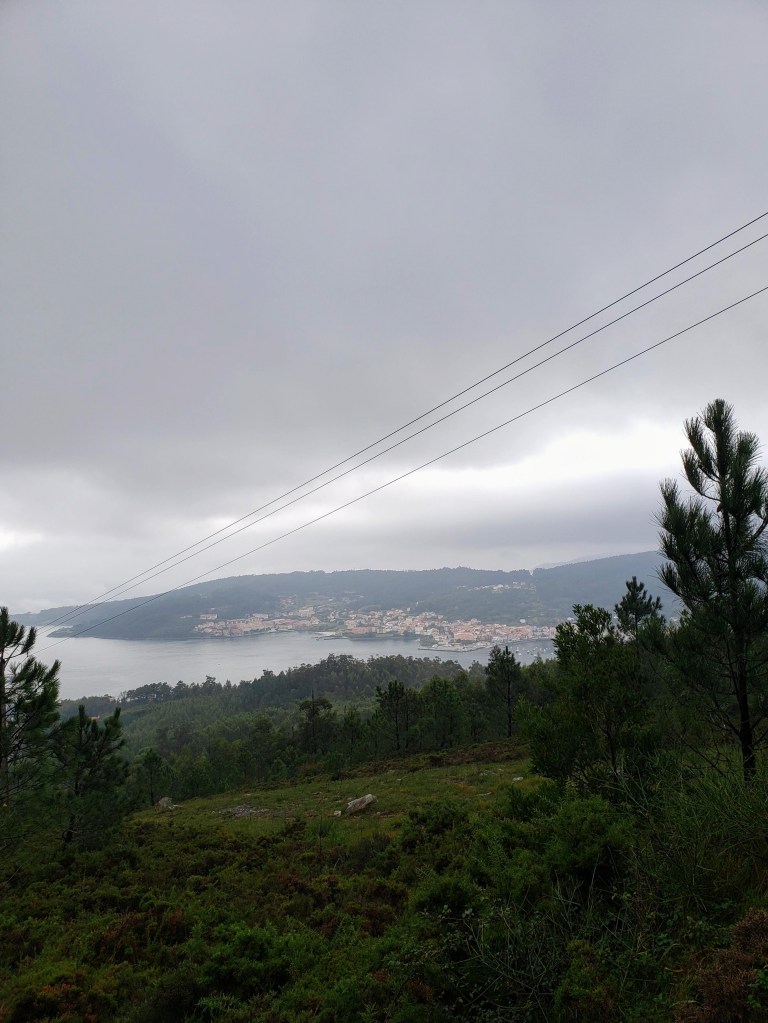
The town of Cee in the distance 
Delicious warm chicken and mushroom salad with honey mustard dressing and gorgonzola pizza. 
Our view from our room



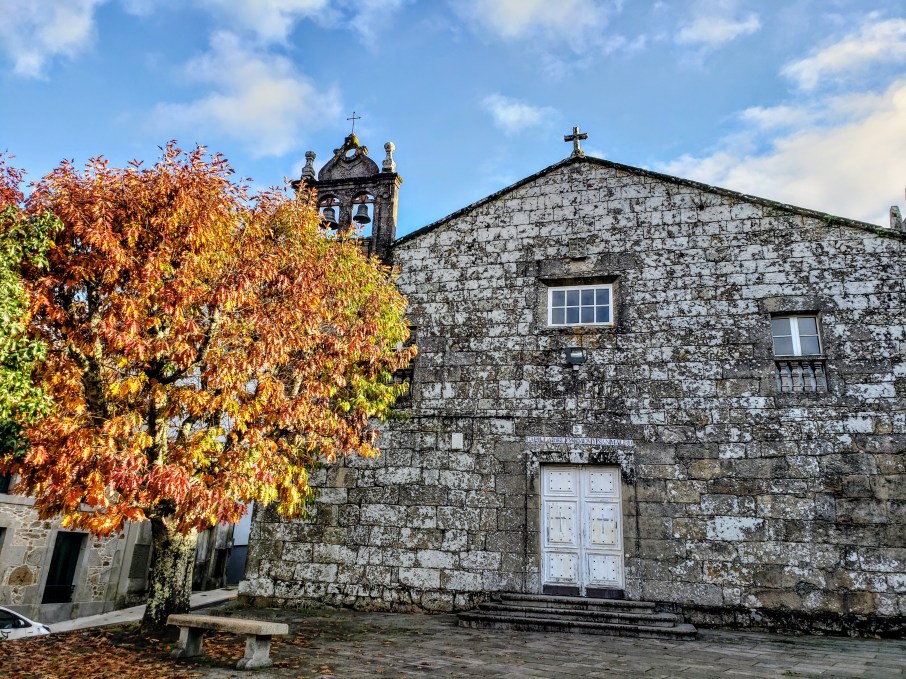




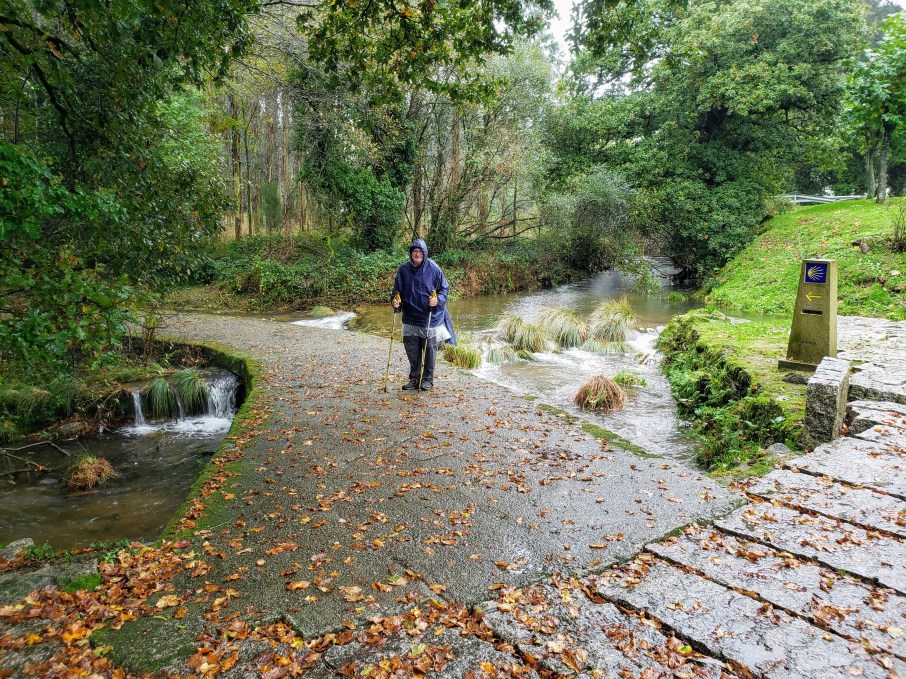
I feel your cold wet squishy shoes! What a precious book of incredible memories. Thank you for continuing to share this amazing experience.
LikeLiked by 1 person
Thanks so much, Cindy! 😊
LikeLike
What a beautiful sweet end of the Camino. It was a great pleasure to read you and I wish you all the best for the rest of the adventure.
LikeLiked by 1 person
Thanks so much for following along!! Greatly appreciated! 😊
LikeLiked by 1 person
Too bad you couldn’t send all of that rain to California. We soooooo NEED it. The fires are still raging and the entire state is blanketed in smoke. It is just HORRIBLE! We left the Central Valley—escaped it, really—to get to Los Angeles for CLEAN air–imagine that concept—but were thwarted by the smoke down there as well. (Although it has gotten far worse in the valley since we left. UGH!)
LikeLiked by 1 person
So sad about the fires …. some Gallaecian rain would certainly help a lot.
LikeLiked by 1 person